2023 ALFA ROMEO STELVIO engine
[x] Cancel search: enginePage 245 of 268
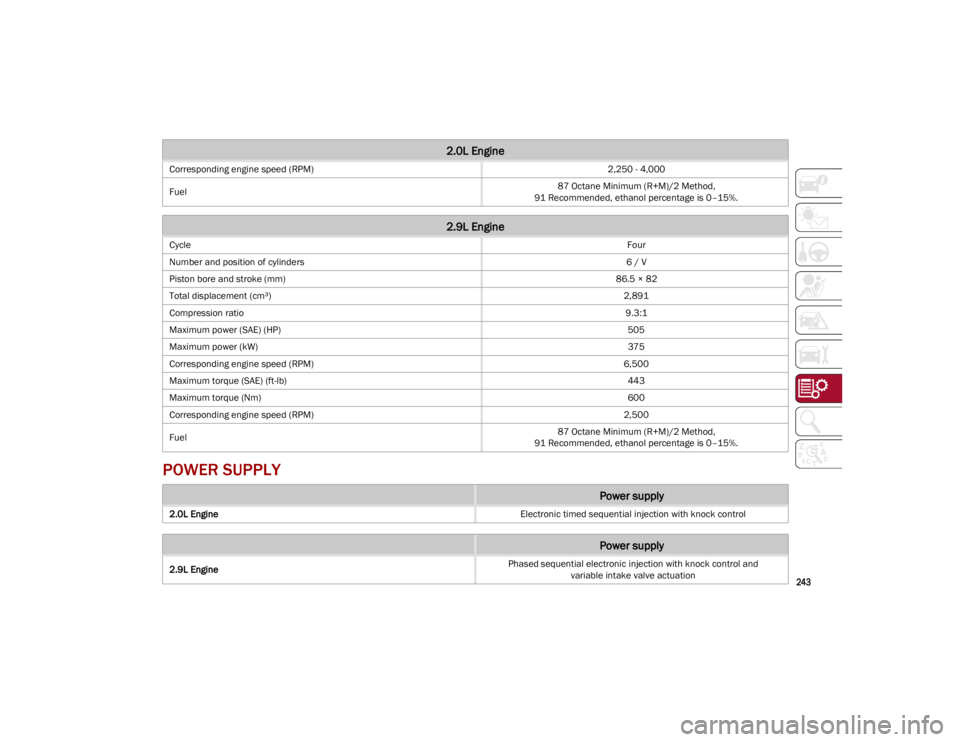
243
POWER SUPPLY
Corresponding engine speed (RPM)2,250 - 4,000
Fuel 87 Octane Minimum (R+M)/2 Method,
91 Recommended, ethanol percentage is 0–15%.
2.9L Engine
Cycle Four
Number and position of cylinders 6 / V
Piston bore and stroke (mm) 86.5 × 82
Total displacement (cm³) 2,891
Compression ratio 9.3:1
Maximum power (SAE) (HP) 505
Maximum power (kW) 375
Corresponding engine speed (RPM) 6,500
Maximum torque (SAE) (ft-lb) 443
Maximum torque (Nm) 600
Corresponding engine speed (RPM) 2,500
Fuel 87 Octane Minimum (R+M)/2 Method,
91 Recommended, ethanol percentage is 0–15%.
Power supply
2.0L Engine Electronic timed sequential injection with knock control
Power supply
2.9L EnginePhased sequential electronic injection with knock control and
variable intake valve actuation
2.0L Engine
23_GU_OM_EN_USC_t.book Page 243
Page 246 of 268
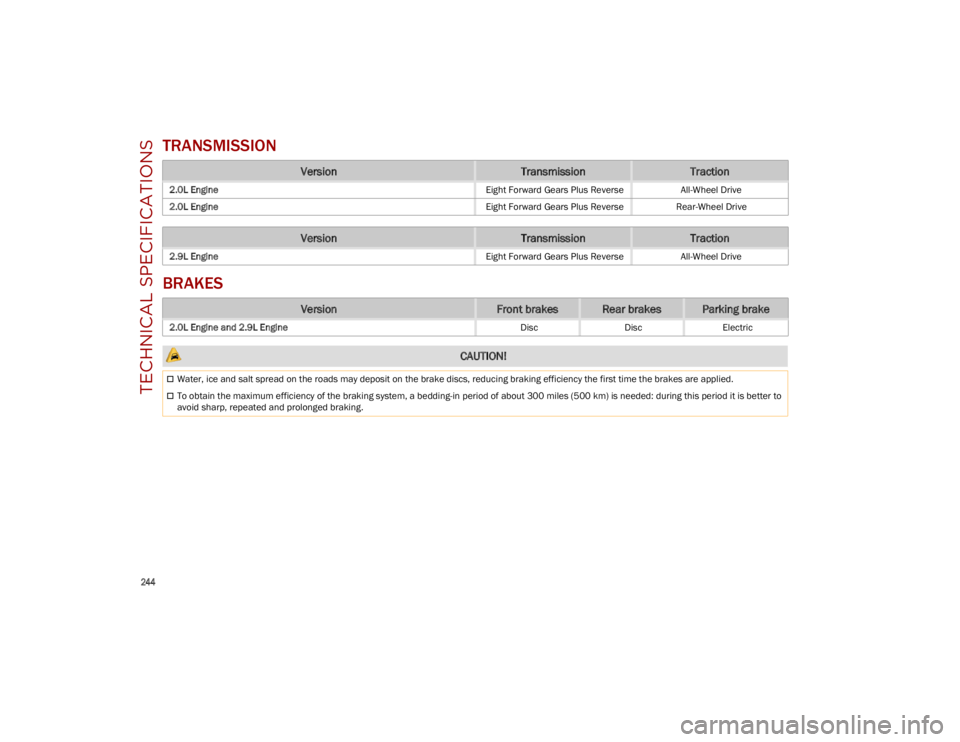
TECHNICAL SPECIFICATIONS
244
TRANSMISSION
BRAKES
VersionTransmissionTraction
2.0L EngineEight Forward Gears Plus ReverseAll-Wheel Drive
2.0L Engine Eight Forward Gears Plus ReverseRear-Wheel Drive
VersionTransmissionTraction
2.9L Engine Eight Forward Gears Plus ReverseAll-Wheel Drive
VersionFront brakesRear brakesParking brake
2.0L Engine and 2.9L Engine DiscDiscElectric
CAUTION!
Water, ice and salt spread on the roads may deposit on the brake discs, reducing braking efficiency the first time the brakes are applied.
To obtain the maximum efficiency of the braking system, a bedding-in period of about 300 miles (500 km) is needed: during this period it is better to
avoid sharp, repeated and prolonged braking.
23_GU_OM_EN_USC_t.book Page 244
Page 247 of 268
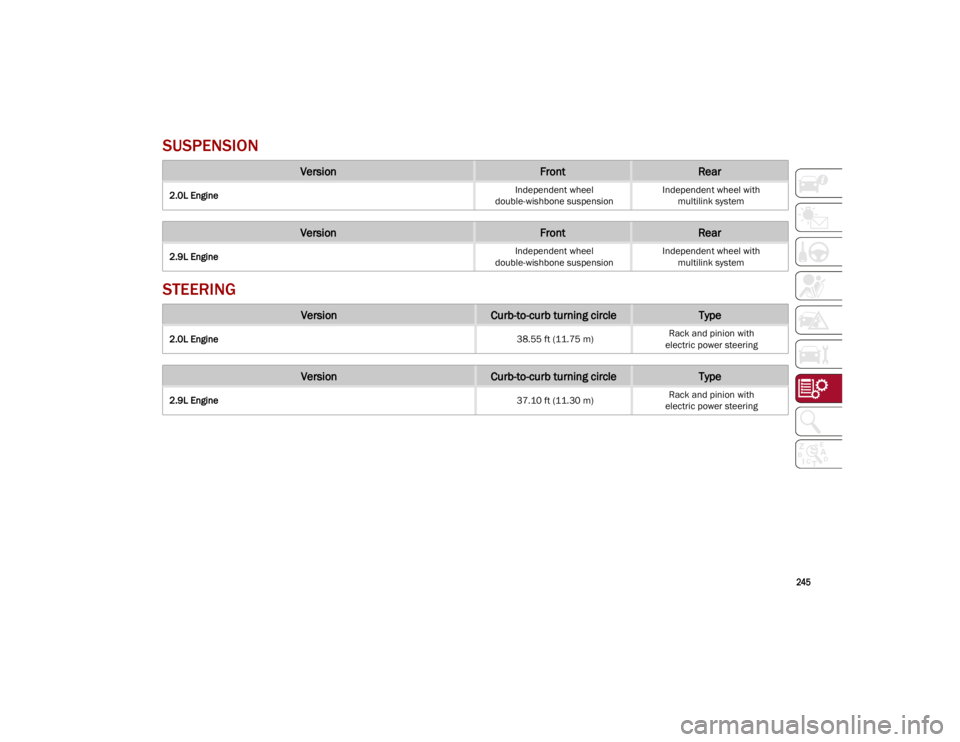
245
SUSPENSION
STEERING
VersionFrontRear
2.0L EngineIndependent wheel
double-wishbone suspension Independent wheel with
multilink system
VersionFrontRear
2.9L Engine Independent wheel
double-wishbone suspension Independent wheel with
multilink system
VersionCurb-to-curb turning circleType
2.0L Engine 38.55 ft (11.75 m)Rack and pinion with
electric power steering
VersionCurb-to-curb turning circleType
2.9L Engine 37.10 ft (11.30 m)Rack and pinion with
electric power steering
23_GU_OM_EN_USC_t.book Page 245
Page 250 of 268
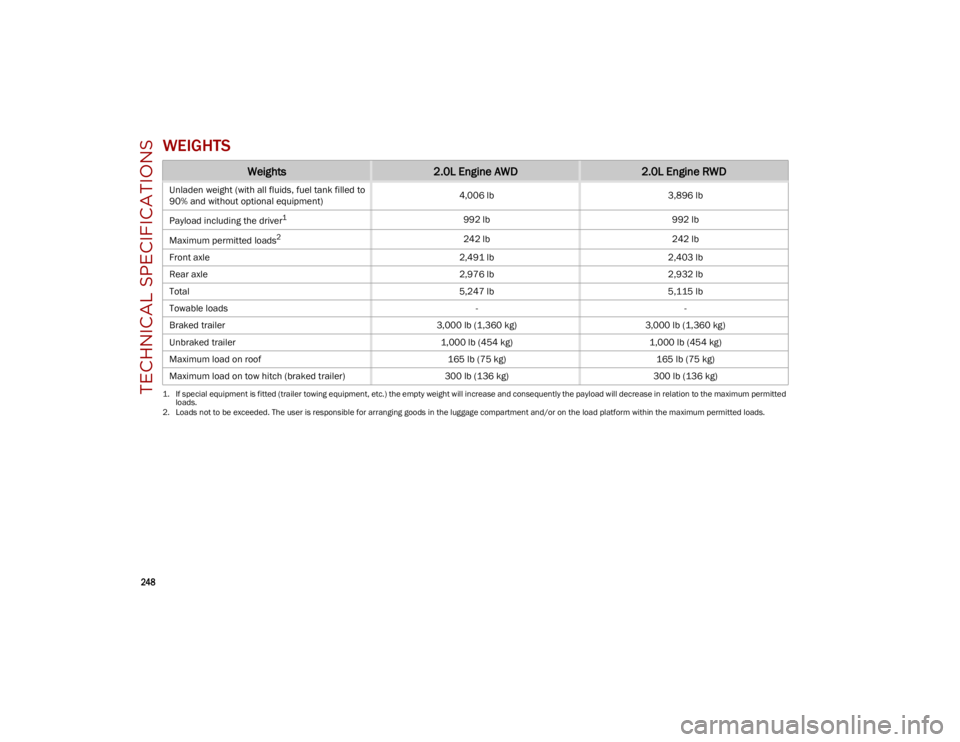
TECHNICAL SPECIFICATIONS
248
WEIGHTS
Weights2.0L Engine AWD2.0L Engine RWD
Unladen weight (with all fluids, fuel tank filled to
90% and without optional equipment) 4,006 lb
3,896 lb
Payload including the driver
1
1. If special equipment is fitted (trailer towing equipment, etc.) the empty weight will increase and consequently the payload will decrease in relation to the maximum permitted loads.
992 lb 992 lb
Maximum permitted loads
2
2. Loads not to be exceeded. The user is responsible for arranging goods in the luggage compartment and/or on the load platform within the maximum permitted loads.
242 lb 242 lb
Front axle 2,491 lb2,403 lb
Rear axle 2,976 lb2,932 lb
Total 5,247 lb5,115 lb
Towable loads --
Braked trailer 3,000 lb (1,360 kg)3,000 lb (1,360 kg)
Unbraked trailer 1,000 lb (454 kg)1,000 lb (454 kg)
Maximum load on roof 165 lb (75 kg)165 lb (75 kg)
Maximum load on tow hitch (braked trailer) 300 lb (136 kg)300 lb (136 kg)
23_GU_OM_EN_USC_t.book Page 248
Page 251 of 268
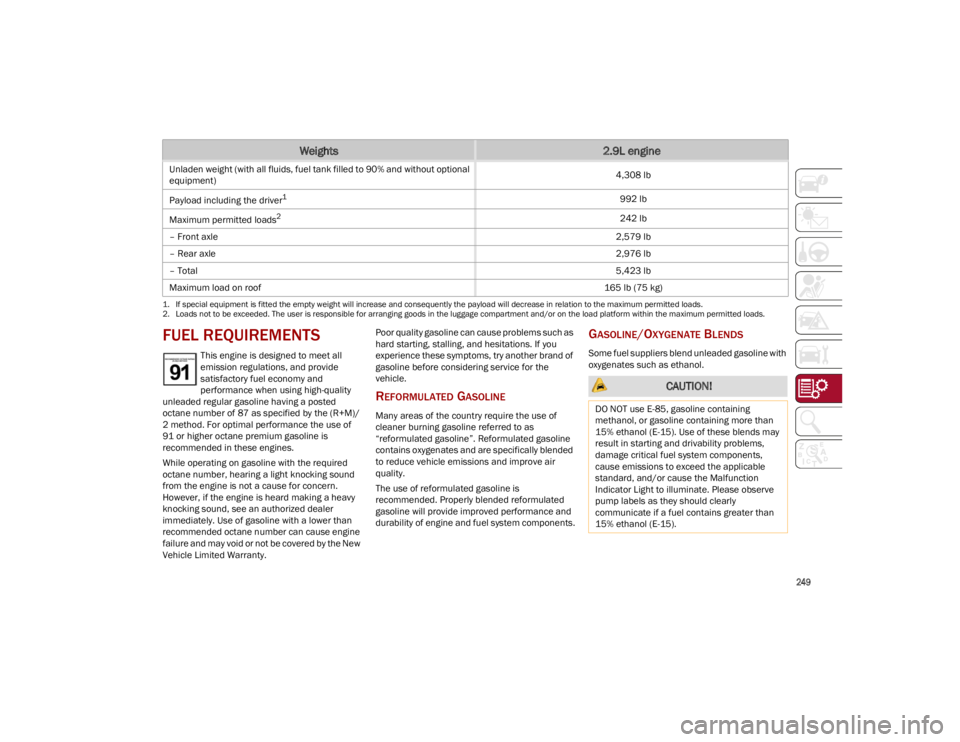
249
FUEL REQUIREMENTS
This engine is designed to meet all
emission regulations, and provide
satisfactory fuel economy and
performance when using high-quality
unleaded regular gasoline having a posted
octane number of 87 as specified by the (R+M)/
2 method. For optimal performance the use of
91 or higher octane premium gasoline is
recommended in these engines.
While operating on gasoline with the required
octane number, hearing a light knocking sound
from the engine is not a cause for concern.
However, if the engine is heard making a heavy
knocking sound, see an authorized dealer
immediately. Use of gasoline with a lower than
recommended octane number can cause engine
failure and may void or not be covered by the New
Vehicle Limited Warranty. Poor quality gasoline can cause problems such as
hard starting, stalling, and hesitations. If you
experience these symptoms, try another brand of
gasoline before considering service for the
vehicle.
REFORMULATED GASOLINE
Many areas of the country require the use of
cleaner burning gasoline referred to as
“reformulated gasoline”. Reformulated gasoline
contains oxygenates and are specifically blended
to reduce vehicle emissions and improve air
quality.
The use of reformulated gasoline is
recommended. Properly blended reformulated
gasoline will provide improved performance and
durability of engine and fuel system components.
GASOLINE/OXYGENATE BLENDS
Some fuel suppliers blend unleaded gasoline with
oxygenates such as ethanol.
Weights2.9L engine
Unladen weight (with all fluids, fuel tank filled to 90% and without optional
equipment) 4,308 lb
Payload including the driver
1
1. If special equipment is fitted the empty weight will increase and consequently the payload will decrease in relation to the maximum permitted loads.
992 lb
Maximum permitted loads
2
2. Loads not to be exceeded. The user is responsible for arranging goods in the luggage compartment and/or on the load platform within the maximum permitted loads.
242 lb
– Front axle 2,579 lb
– Rear axle 2,976 lb
– Total 5,423 lb
Maximum load on roof 165 lb (75 kg)
CAUTION!
DO NOT use E-85, gasoline containing
methanol, or gasoline containing more than
15% ethanol (E-15). Use of these blends may
result in starting and drivability problems,
damage critical fuel system components,
cause emissions to exceed the applicable
standard, and/or cause the Malfunction
Indicator Light to illuminate. Please observe
pump labels as they should clearly
communicate if a fuel contains greater than
15% ethanol (E-15).
23_GU_OM_EN_USC_t.book Page 249
Page 252 of 268

TECHNICAL SPECIFICATIONS
250
(Continued)
Problems that result from using gasoline
containing more than 15% ethanol (E-15) or
gasoline containing methanol are not the respon
-
sibility of the manufacturer and may void or not
be covered under New Vehicle Limited Warranty.
CNG AND LP FUEL SYSTEM
M
ODIFICATIONS
Modifications that allow the engine to run on
Compressed Natural Gas (CNG) or Liquid
Propane (LP) may result in damage to the engine,
emissions, and fuel system components.
Problems that result from running CNG or LP are
not the responsibility of the manufacturer and
may void or not be covered under the New
Vehicle Limited Warranty.
MMT IN GASOLINE
Methylcyclopentadienyl Manganese Tricarbonyl
(MMT) is a manganese-containing metallic
additive that is blended into some gasoline to
increase octane. Gasoline blended with MMT
provides no performance advantage beyond
gasoline of the same octane number without
MMT. Gasoline blended with MMT reduces
spark plug life and reduces emissions system
performance in some vehicles. The manufacturer
recommends that gasoline without MMT be used
in your vehicle. The MMT content of gasoline may
not be indicated on the gasoline pump; therefore,
you should ask your gasoline retailer whether the
gasoline contains MMT. MMT is prohibited in
Federal and California reformulated gasoline.
MATERIALS ADDED TO FUEL
Besides using unleaded gasoline with the proper
octane rating, gasolines that contain detergents,
corrosion and stability additives are
recommended. Using gasolines that have these
additives will help improve fuel economy, reduce
emissions, and maintain vehicle performance.
Designated TOP TIER Detergent
Gasoline contains a higher level of
detergents to further aide in minimizing
engine and fuel system deposits.
When available, the usage of TOP TIER Detergent
Gasoline is recommended. Visit
www.toptiergas.com
for a list of TOP TIER
Detergent Gasoline retailers.
Indiscriminate use of fuel system cleaning agents
should be avoided. Many of these materials
intended for gum and varnish removal may
contain active solvents or similar ingredients.
These can harm fuel system gasket and
diaphragm materials.
FUEL SYSTEM CAUTIONS
NOTE:
Intentional tampering with the emissions control
system can result in civil penalties being
assessed against you.
CAUTION!
Follow these guidelines to maintain your
vehicle’s performance:
The use of leaded gasoline is prohibited by
Federal law. Using leaded gasoline can
impair engine performance and damage the
emissions control system.
An out-of-tune engine or certain fuel or
ignition malfunctions can cause the catalytic
converter to overheat. If you notice a
pungent burning odor or some light smoke,
your engine may be out of tune or malfunc-
tioning and may require immediate service.
Contact an authorized dealer for service
assistance.
The use of fuel additives, which are now
being sold as octane enhancers, is not
recommended. Most of these products
contain high concentrations of methanol.
Fuel system damage or vehicle performance
problems resulting from the use of such fuels
or additives is not the responsibility of the
manufacturer and may void or not be
covered under the New Vehicle Limited
Warranty.
CAUTION!
23_GU_OM_EN_USC_t.book Page 250
Page 253 of 268
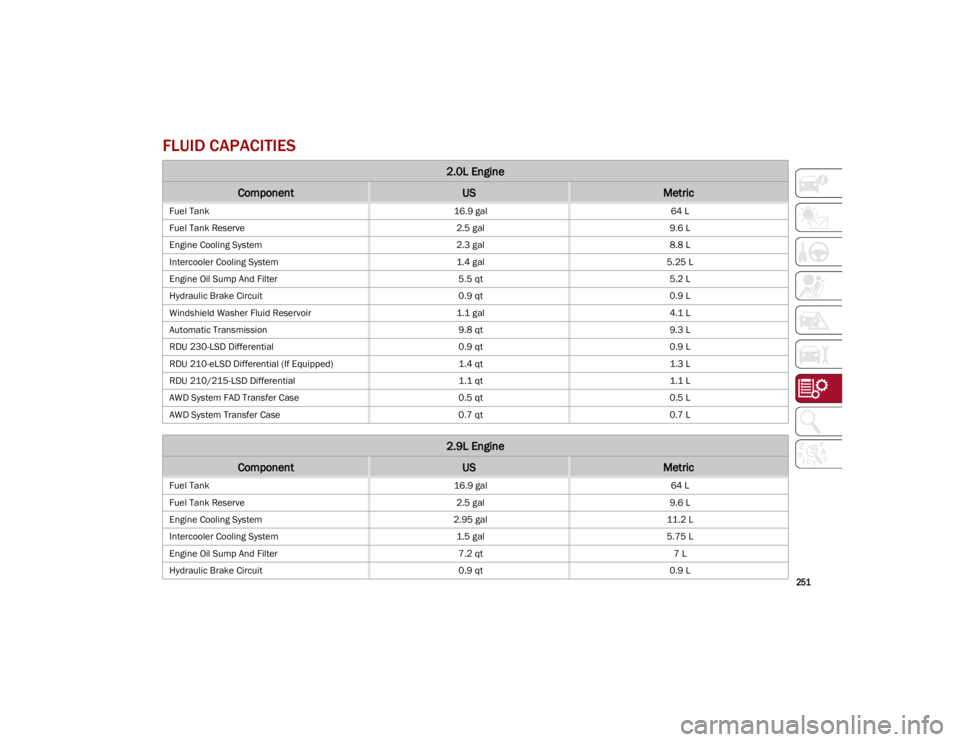
251
FLUID CAPACITIES
2.0L Engine
ComponentUSMetric
Fuel Tank16.9 gal64 L
Fuel Tank Reserve 2.5 gal9.6 L
Engine Cooling System 2.3 gal8.8 L
Intercooler Cooling System 1.4 gal5.25 L
Engine Oil Sump And Filter 5.5 qt5.2 L
Hydraulic Brake Circuit 0.9 qt0.9 L
Windshield Washer Fluid Reservoir 1.1 gal4.1 L
Automatic Transmission 9.8 qt9.3 L
RDU 230-LSD Differential 0.9 qt0.9 L
RDU 210-eLSD Differential (If Equipped) 1.4 qt1.3 L
RDU 210/215-LSD Differential 1.1 qt1.1 L
AWD System FAD Transfer Case 0.5 qt0.5 L
AWD System Transfer Case 0.7 qt0.7 L
2.9L Engine
ComponentUSMetric
Fuel Tank 16.9 gal64 L
Fuel Tank Reserve 2.5 gal9.6 L
Engine Cooling System 2.95 gal11.2 L
Intercooler Cooling System 1.5 gal5.75 L
Engine Oil Sump And Filter 7.2 qt7 L
Hydraulic Brake Circuit 0.9 qt0.9 L
23_GU_OM_EN_USC_t.book Page 251
Page 254 of 268
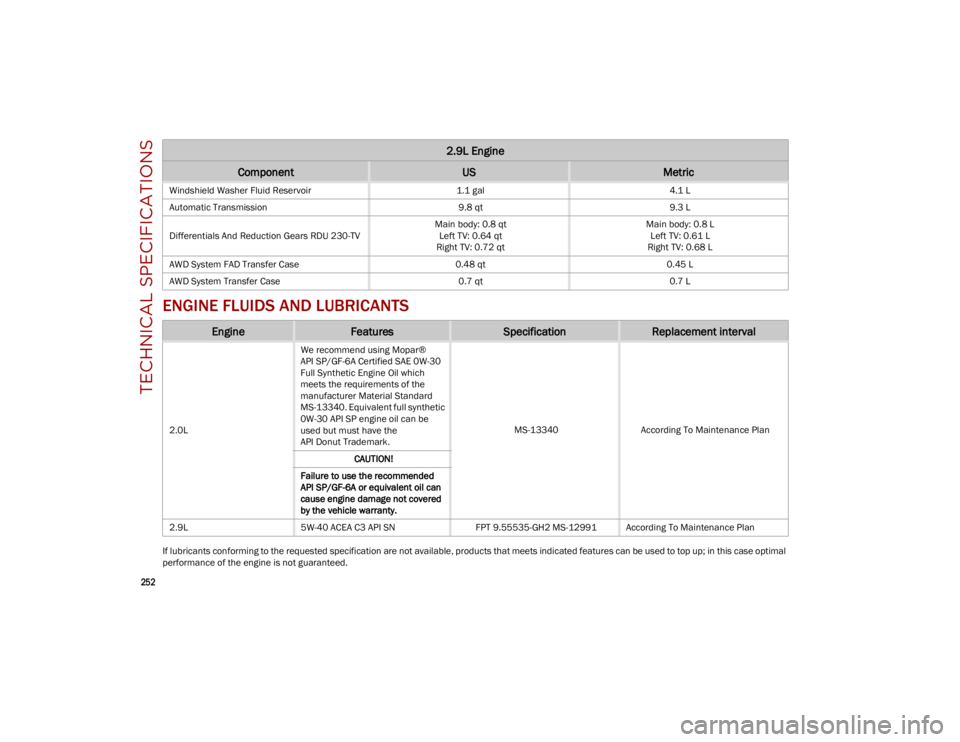
TECHNICAL SPECIFICATIONS
252
ENGINE FLUIDS AND LUBRICANTS
If lubricants conforming to the requested specification are not available, products that meets indicated features can be used to top up; in this case optimal
performance of the engine is not guaranteed.Windshield Washer Fluid Reservoir
1.1 gal4.1 L
Automatic Transmission 9.8 qt9.3 L
Differentials And Reduction Gears RDU 230-TV Main body: 0.8 qt
Left TV: 0.64 qt
Right TV: 0.72 qt Main body: 0.8 L
Left TV: 0.61 L
Right TV: 0.68 L
AWD System FAD Transfer Case 0.48 qt0.45 L
AWD System Transfer Case 0.7 qt0.7 L
EngineFeaturesSpecificationReplacement interval
2.0LWe recommend using Mopar®
API SP/GF-6A Certified SAE 0W-30
Full Synthetic Engine Oil which
meets the requirements of the
manufacturer Material Standard
MS-13340. Equivalent full synthetic
0W-30 API SP engine oil can be
used but must have the
API Donut Trademark. MS-13340
According To Maintenance Plan
CAUTION!
Failure to use the recommended
API SP/GF-6A or equivalent oil can
cause engine damage not covered
by the vehicle warranty.
2.9L 5W-40 ACEA C3 API SN FPT 9.55535-GH2 MS-12991 According To Maintenance Plan
2.9L Engine
ComponentUSMetric
23_GU_OM_EN_USC_t.book Page 252